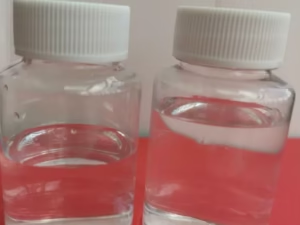Description
2-Ethylhexanol: A Versatile Alcohol with Wide-Ranging Applications
2-Ethylhexanol (often abbreviated as 2-EH) is a branched, eight-carbon, chiral alcohol with the chemical formula CH3(CH2)3CH(C2H5)CH2OH. This colorless liquid with a characteristic odor is a significant industrial chemical, finding its uses across a diverse range of applications. Its versatility stems from its unique combination of properties, including its solvency, low volatility, and favorable reactivity.
Production and Synthesis:
2-Ethylhexanol is primarily produced via the aldol condensation of n-butyraldehyde, followed by hydrogenation. The n-butyraldehyde itself is obtained from the hydroformylation of propylene, a reaction that utilizes syngas (a mixture of carbon monoxide and hydrogen):
- Hydroformylation of Propylene: Propylene + CO + H2 → Butyraldehyde
- Aldol Condensation: 2 Butyraldehyde → 2-Ethylhexenal + H2O
- Hydrogenation: 2-Ethylhexenal + H2 → 2-Ethylhexanol
This process allows for large-scale production, making 2-EH readily available and cost-effective for industrial use.
Key Applications:
The majority of 2-ethylhexanol produced is used as a precursor in the synthesis of other chemicals. Here are some of its most prominent applications:
- Plasticizers: By far the largest application of 2-EH is in the production of di(2-ethylhexyl) phthalate (DEHP), also known as dioctyl phthalate (DOP). DEHP is a crucial plasticizer used in PVC (polyvinyl chloride) plastics, making them more flexible and durable. While concerns exist regarding the health impacts of DEHP, it remains widely used in various applications. Alternatives utilizing 2-EH, such as di(2-ethylhexyl) adipate (DEHA), are also gaining popularity due to their improved safety profile.
- Solvents: 2-Ethylhexanol is an excellent solvent for a variety of substances, including resins, oils, waxes, and inks. Its low volatility and good solvency make it suitable for use in paints, coatings, and adhesives.
- Defoamers: 2-Ethylhexanol acts as a defoaming agent in various industrial processes, particularly in paper pulping, textile processing, and wastewater treatment. It reduces surface tension, causing bubbles to collapse and preventing the formation of stable foam.
- Chemical Intermediates: 2-Ethylhexanol serves as a building block in the synthesis of a variety of other chemicals, including:
- 2-Ethylhexyl Acrylate: Used in the production of pressure-sensitive adhesives, coatings, and textiles.
- 2-Ethylhexyl Nitrate: A cetane improver added to diesel fuel to improve combustion and reduce emissions.
- Ethoxylated 2-Ethylhexanol: Used as a surfactant in detergents, cleaners, and emulsifiers.
- Other Applications: 2-Ethylhexanol also finds applications in:
- Metalworking fluids: As a lubricant and coolant.
- Mining: As a flotation agent.
- Photography: As a solvent and stabilizer.
Safety and Environmental Considerations:
While 2-Ethylhexanol is generally considered to have low acute toxicity, it’s important to handle it with care. Prolonged or repeated exposure can cause skin and eye irritation. Inhalation of high concentrations can cause respiratory irritation. Proper ventilation and personal protective equipment should be used when handling this chemical.
From an environmental perspective, 2-Ethylhexanol is considered readily biodegradable, meaning it breaks down relatively quickly in the environment. However, its widespread use requires responsible management to minimize potential environmental impact.
Conclusion:
2-Ethylhexanol is a highly versatile and important industrial chemical with a wide range of applications. From plasticizers to solvents to chemical intermediates, its unique properties make it an indispensable component in numerous industries. While safety and environmental concerns exist, responsible handling and the development of safer alternatives are crucial to ensuring its continued use in a sustainable manner. As technology and consumer demand evolve, the applications of 2-Ethylhexanol are likely to continue to adapt and diversify, solidifying its position as a key building block in the chemical industry.























Reviews
There are no reviews yet.